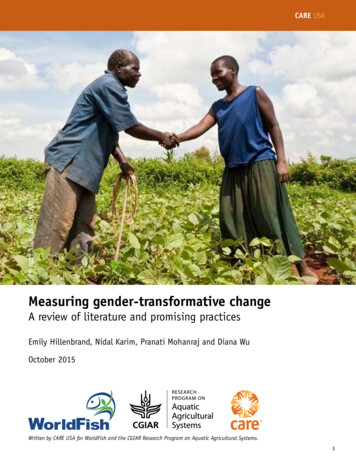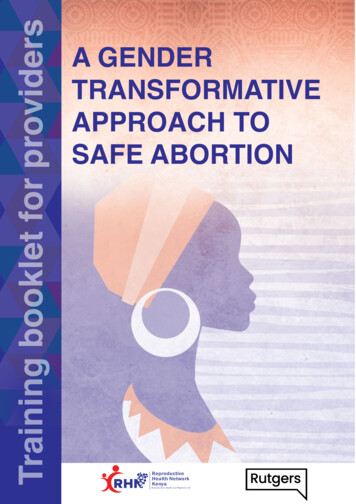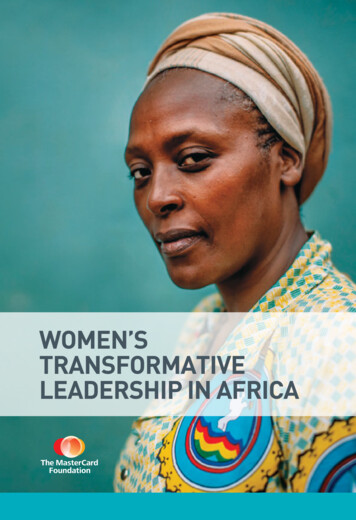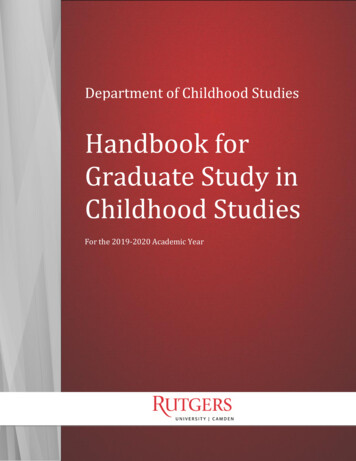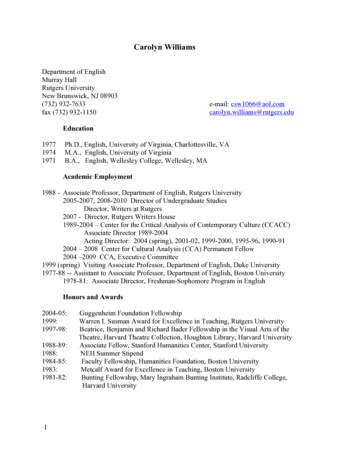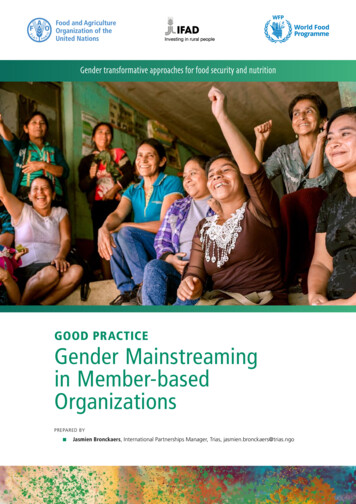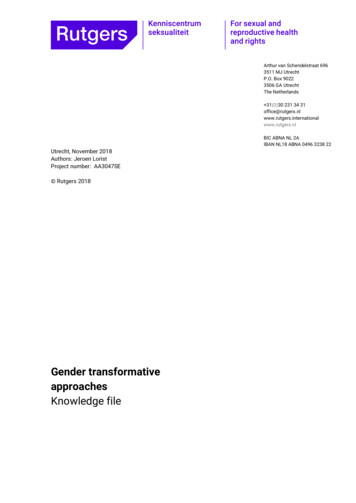
Transcription
Arthur van Schendelstraat 6963511 MJ UtrechtP.O. Box 90223506 GA UtrechtThe Netherlands 31(0)30 231 34 tgers.nlUtrecht, November 2018Authors: Jeroen LoristProject number: AA3047SE Rutgers 2018Gender transformativeapproachesKnowledge fileBIC ABNA NL 2AIBAN NL18 ABNA 0496 3238 22
Index211.1IntroductionThe role of the socio-ecological model in a GTA3422.1.12.1.22.1.32.2Theoretical insights - awareness of social dimension of gender and sexSocial normsThe relationship between sexual scripts and harmful traditional gender normsThe sexual double standardThe harmful effects of traditional gender norms and the sexual double standard on(adolescent) sexual and reproductive health (ASRH)Gender norms and ASRHGender norms and gender based violenceHarmful effects of traditional gender norms and SDS on contraceptive useHarmful effects of traditional gender norms and SDS on abortionHarmful effects of traditional gender norms and SDS on population issuesHarmful effects of heteronormativity and homophobia on SOGIESCEffects of the double standard and traditional gender norms in the NetherlandsEmpowering women, girls and people with diverse SOGIESCEngaging boys and men in SRHR and gender equalityStrengthening the capacity of duty bearers in a 53Gender transformative approachesRutgers 3.23.3.33.43.4.13.4.2Transforming inequitable gender norms: A listing of most relevant GTA practicesfor Rutgers’ Theory of ChangeGeneral InterventionsRutgers’ Gender Transformative Approach: Six interrelated topics, as part of theGTA ToolkitKey gender transformative interventions focused on improving education andinformation on SRHRAdolescent Boys and Young Men - Sexuality and RelationshipsBeat the Macho/LEFgozersCan you fix it?Respect LimitsProgram H, MKey gender transformative interventions focused on improving (Youth Friendly)SRH ServicesProgram PToolkit for Men: Male CounsellingAlliantie Gezondheidszorg op MaatKey gender transformative interventions focused on improving the EnablingEnvironmentAct4RespectModule 4: Toolkit on GTA and 171818181919191920
1IntroductionThis whitepaper provides an overview of national and international knowledge, research andinterventions regarding gender transformative approaches (GTA) as is considered relevant forRutgers' sexual and reproductive health and rights (SRHR) programmes. Besides a definition ofgender transformative approach, state of the art knowledge, evaluated practices and an overview ofkey interventions within the GTA field will be presented. The whitepaper is intended for SRHRprofessionals who want to learn more about what a gender transformative perspective implies forthem in practice.3But why is gender transformative thinking and practice important for Rutgers and what does itactually entail? The main reason why Rutgers sees GTA as an overarching principle in its overallstrategy is because ”restrictive sexual and gender norms are preventing people from receiving theinformation and services they need to make safe and informed decisions and to fulfil their sexualand reproductive health and rights.” (Rutgers, 2017).Restrictive sexual and gender norms are motivated by religious, social and cultural views and beliefs,and have an impact on the sexuality of young people, women, people with a non-heterosexualorientation, and people with different gender identities. The heterosexual norm and the sexual doublestandard still very much prevail. Evidence is growing that patriarchal gender norms not only havenegative implications for women and children but also for men themselves (WHO, 2007). As aconsequence of these restrictive sexual and gender norms, many people worldwide are notacknowledged in their sexuality, and their sexual and reproductive rights are violated. (RutgersStrategy 2017-2020).Restrictive sexual and gender norms and stereotypical perceptions of what it means to be a man or awoman can promote unequal gender relations that often put men in a position of sexual dominanceand can limit women’s ability to control their reproductive and sexual health and rights. The core of aGTA is therefore changing these restrictive norms and the often unequal power relations thatmaintain these norms.The following working definition of the Rutgers GTA has been informed by the work of Rolleri (2014).The Rutgers Gender Transformative Approach actively strives to examine, question, and change rigidgender norms and imbalances of power as a means of achieving SRHR objectives, as well as genderequality objectives at all levels of the socio ecological model. Gender transformative programs andpolicies.1. .encourage critical awareness of gender roles, norms and power relations.2. .question and evince the costs (financial, social, psychological etc.) of harmful, inequitable gendernorms and power relations in relation to SRHR and making explicit the advantages of changingthem.3. .empower women/girls and people with diverse sexual orientation, gender identity, genderexpression and/or sex characteristics (SOGIESC).4. .engage boys and men in SRHR and gender equality.5. .engage duty bearers on gender and power relations.In 2000, Gupta coined a now familiar conceptual framework with the aim to classify the degree towhich SRHR interventions engage critically with gender related issues in their design, implementationGender transformative approachesRutgers 2018Although the Netherlands has a reputation of tolerance and openness about sex, the double standardstill exists among young people, meaning that boys have more sexual privileges than girls(Emmerink, 2018). Furthermore, although tolerance regarding homosexuality is relatively high in theNetherlands (Kuyper, 2016) negative attitudes among young people towards homosexuality are quitecommon: 57% of boys and 31% of girls between 12 and 25 disapprove of two boys having sex, and24% of boys and 30% of girls feel the same about two girls having sex (De Graaf, 2012; Rutgers,2017).
4and evaluation (Gupta, 2000), which has been further developed by the Inter-Agency Gender WorkingGroup from USAID (IGWG, 2016) and distinguishes the following categories: Gender Exploitative Programs may reinforce or take advantage of traditional gender roles andnorms. E.g. a campaign that uses aggressive images of masculinity to sell condoms mayreproduce traditional roles of men being the dominant partner in sexual relationships. Gender Neutral or Gender Blind Programs may fail to acknowledge the role of power. Byignoring socio-economic and political inequalities they may, often unintentionally, condoneharmful gender norms. E.g. condoms are distributed to boys and men, while the option ofdistributing them to girls and women, including the female condom, is not considered. This couldreinforce contextual norms that men control condom use. Gender Sensitive Programs gender sensitive programs recognize existing inequities, but mayfail to actively seek to change gender norms and power relations. For example, girls may betaught to defend themselves against sexual violence, but the program fails to challengepatriarchal norms or include boys and men in discussions around violence. Gender Transformative Programs aim to transform gender roles, norms and power relations tocreate more gender equitable outcomes, fostering constructive roles for men, women andSOGIESC in and gender equality and SRHR.1.1The role of the socio-ecological model in a GTAGender transformative approachesRutgers 2018Research on SRHR programmes has shown that multilevel approaches, i.e. working simultaneouslyon different levels of the socio-ecological model, are more effective than focusing on interventions ata single level (SRHR Alliance, 2015; Martens, 2015). This ‘system thinking’ is supported by a metaevaluation of the World Health Organisation covering 58 evaluation studies, which provides evidencethat gender transformative SRHR programmes that are integrated and therefore address genderinequality at the individual, community and institutional level at the same time have better outcomesthan programs that ignore the surrounding environment (WHO, 2007).Source: Edström & Shahrokh/Reframing Men and Boys in Policy for Gender Equality: Conceptual Guidance and anAgenda for Change. - EMERGE Framing Paper: Promundo-US, Sonke Gender Justice and the Institute of DevelopmentStudies, Brighton: IDS, 2016.There is a growing body of evidence that a multi-component programmes, informed by this modelcan lead to improved SRHR of men/boys and women/girls, the prevention of GBV and genderequality and works better than approaches that focus on for instance the individual level only (Doyle,2014). Hence Rutgers’ GTA includes a socio-ecological approach in all of its SRHR programmes.Elements in a gender transformative approach (GTA).
2Theoretical insights - awareness of socialdimension of gender and sexThe first element within a gender transformative approach, if we broadly follow Rolerri's definition, isto raise critical awareness on the social dimensions of sex and gender. Broadly speaking, within thescientific endeavour there are two ways of understanding difference and the complex relationshipbetween gender and sexuality, both with different epistemological and ontological assumptions,often referred to as the nature-nurture debate.5An essentialist view beliefs in factual observation, biological determinism, stability, 'hardwiredness'of human behaviour, simplistic explanations and cross-cultural similarities (i.e. the ‘nature’ position)It stresses difference between the sexes in terms of gender. In contrast, a social-constructionistperspective sees reality and knowledge as socially constructed, under the influence of social-culturalinfluences, and stresses cross-cultural diversity, complexity and multiplicity (i.e. the ‘nurture’position). In addition, generally speaking, a move from modern to postmodern approaches tounderstand the concept of gender can be distinguished. The dominant scientific paradigm is movingbeyond unilinear relationships and recognises that the relationship between nature and nurture isdynamic rather than static. Generally the focus seems to move from "socialization to performativity,from difference to diversity etc." (Vanwesenbeeck, 2009).For example Sandra Bem's gender schema theory suggests that children learn about what it meansto be male and female from their culture (cultural norms) from the earliest stages of developmentonwards. According to her theory children adjust their behaviour to fit with the gender norms andexpectations (i.e. through rewards and punishments) of their culture. This theory is a merger ofPiaget’s cognitive development approach (Ryle, 2011) and the social learning approach (Bandura,1969) that stresses observational learning. Bandura's account of gender allows for more thancognitive factors in predicting gendered behaviour. For Bandura, motivational factors and a broadnetwork of social influences determine if, when, and where gender knowledge is expressed (Miller,2011). These insights point to the need for early interventions and the involvement of role-models inthe direct environment of a child or young person, such as teachers, care givers, peers etc. topositively influence gender attitudes and behaviour. Sexual script theory will be further detailedbelow, as it exemplifies how the sexual double standard for boys and men, and women and girl ispersistently continuing to create inequalities.Post-structuralist understandings of the social and the ‘self’ explain that a person’s relationship withthe complex network of power relations is always mediated by a web of imaginary relations,situationally embodied into the potentially constructive or destructive web of relations of power(Braidotti, 2011). The concept of the imaginary which Braidotti sees as a complex network ofinterrelated social and discursive effects is central to understanding the relationship between thesocial and the self. Inspired by Deleuze and Foucault, Braidotti also embraces feminist intersectionaltheory as our open ended ever changing, multiple and “complex structures of identity, are lived outdifferently depending on one’s specific positionality with the global economy and global powerrelations” (Goswami, 2014). Positioned within a gender transformative approach this suggests a GTAshould take in account the intersectionality with other social markers of difference like class, race,age, poverty etc. in line with Cernshaw’s theory of intersectionality (Crenshaw, 1989). In addition, alsobuilding on Foucault, according to Butler (Butler, 2006) gender is not ontological (i.e. there is no inneressence to gender identity) but is situationally ‘performed’ through actions (i.e. gender isGender transformative approachesRutgers 2018As a result, contemporary research endeavours try to understand the complex relationship betweensex, gender and the social environment through multi-and interdisciplinary research, which providesdifferent partially overlapping and often complementary perspectives on gender and sexuality. Someof the more prominent theoretical insights that are useful for a theoretically informed gendertransformative approach are, for instance, social learning theory (Bandura, 1977; Miller, 2011; Ryle,2011), sexual script theory (Wiederman, 2005; Simon and Gagnon, 1984) gender schema theory(Bem, 1981), the post-structuralist perspectives (Foucault, 1984), post-structuralist feminist theory(Butler, 1984; Braidotti, 2011) and neuroscientific accounts of difference (Baron-Cohen, 2003).
6‘performative’). Simply put gender and sex are considered a social construction rather than anessential part of one’s being.Even within the exact sciences such as biology, scholars now recognise that sex is more fluid thanpreviously assumed. For example there is vast evidence from the biological and behaviouralsciences that from the earliest points in development, gene activity interacts with events andexperiences in the environment (Carlson, 2005). Hence neuropsychological arguments thatessentialise differences (men are from Mars, women from Venus) are not only erroneous, but in theirneuro-sexism potentially also reinforce the sexual double standards (Fine, 2010). In addition, Fine(2010, 2017) highlights methodological faults in popular, Mars versus Venus discourse like that ofBaron-Cohen and others. Her conclusion is further buttressed by research by Joel et al. (2015) whoconvincingly show that there is no clear 'male' or 'female' brain or personality for that matter. Mencan be caring and women can be competitive - gender is fluid and diverse. For a gendertransformative approach this implies that new empowering ways of thinking and social acting, or‘doing gender’ (West, 1987; Vanwesenbeeck, 2009), are possible without stressing essentialist andpotentially discriminatory differences (Grosz, 2011).In summary these joint theoretical insights suggest that there is more to sexual difference than the‘male’ ‘female’ divide alone. "Rather, it should be acknowledged that gendered sexuality (broadlydefined as all sexually tainted social interaction informed by gender norms) is a multifaceted,multidetermined social process, strongly affected by societal and personality factors, showing hugewithin-sex diversity and intra-individual variability, and, ultimately, put into effect on a day-to-daybasis in various sorts of human social relations and spheres" (Vanwesenbeeck, 2009). This supportsa gender transformative approach that operates on different levels of the socio-ecological modelsimultaneously and allows for ‘doing more positive and more equitable gender’.Gender transformative approachesRutgers 20182.1.1Social normsGenerally sociology emphasises the role norms play in organising society and influencing socialbehaviour, whilst social psychology and game theory tend to emphasise why people comply withsocial and gender norms. Much recent research on social norms has drawn primarily on the lattertwo traditions (Marcus, 2014).Recent insights in social norms highlight two elements: beliefs of what is normal in a group, thedescriptive norm (generally accepted gender roles in a virtual or real community) and beliefs aboutwhat people should do, the conjunctive norm (broadly linked to gender ideologies like patriarchy)(Ball, 2012; Paluk, 2010). This insight may help to understand why some aspects of gender normsmay transform more quickly than others. In general it is easier to change attitudes (which arepersonal), more difficult to change gender roles and most difficult to change ideologies (i.e.injunctive normative ideal that operate on a largely non-conscious level) (Marcus, 2014). A growingbody of feminist analysis helps to understand the factors that facilitate or inhibit norm change. Thatis, their level of so called 'stickiness’. A key observation from Mackie et. al. (2009) highlights thatsocial norms are often over determined (sticky) by multiple factors often operating at different levelsof the socio-ecological model simultaneously. Hence transformation of one factor may not changethe harmful gender norm.For a general understanding of how sexual and gender norms are related to culture and norms, agender transformative approach can learn a thing or two from sexual script theory.2.1.2The relationship between sexual scripts and harmful traditional gender normsSexual script theory argues that sexual behaviour in hetero-sexual relations follow a given socialscript that represents the social norm in a given context. Generally, traditional sexual scripts tend toascribe men with greater power and control during sexual interactions (Wiederman, 2005). Incontrast, most often women are expected to be submissive and wait for their male partners toinitiate sexual activity (Rutter, 2000). From a social psychological perspective, the sexual script- andthe sexual cognition literature shows that, “despite evidence that men and women’s sex roles are
becoming more egalitarian over time, empirical evidence suggests that traditional sex roles continueto dominate heterosexual relations” (Sanchez, 2012).The questions is whether these Euro-American findings can also be generalised for lower and middleincome countries in which Rutgers implements part of its programmes. A recent systematic reviewof 82 peer-reviewed studies suggest that this indeed the case and that regardless of cultural setting,the majority of early adolescents (10-14 years of age) generally support norms that reproduce andmaintain gender inequalities, and that teachers, caregivers and peers are especially central inshaping such attitudes. Early adolescents around the world support a type of masculinity "predicatedon toughness/competitiveness and heterosexual prowess, in contradistinction to femininitypredicated on weakness, physical appearance and the control and shaming of female sexuality"(Kågesten, 2016). However, the same review also mentions evidence of young people challengingstereotypical gender norms, suggesting that gender attitudes (among this age group) are subject tochange. For the GTA, this implies a ‘window of opportunity’ to influence gender norms during theformation of gender identities in early adolescence (Kågesten, 2017).7Generally speaking, the sociopsychological perspective shows that (hetero-sexual) gender typicalbehaviour is most likely when there are strong social scripts in a given context, when the specificcontext makes gender differences salient and when a sexual partner (and subject for that matter)has more traditional gender beliefs and expectations (Sanchez, 2012; Vanwesenbeeck, 2009).According to Sanchez et. al. (2012) interventions should therefore focus on the perceptions of sexualpartners. In relation to gender transformative approaches this would imply critically engaging boysand men in raising awareness of their attitudes and harmful gender norms. More on this element ofthe gender transformative approach will follow below.The sexual double standardAs has become clear in the previous section, sexual scrips are strongly influenced by a doublestandard or double moral. The sexual double standard (SDS) can be defined as a "divergent set ofexpectations for boys and men, and girls and women for engaging in romantic and sexual behaviour"(Emmerink, 2017; Vanwesenbeeck, 2009). These gender norms determine largely what is consideredappropriate behaviour for each category in a certain time or context. They influence cognition,attitudes and behaviour throughout the life cycle. In general, romantic and sexual engagements aremost affected by sexual double standards (Emmerink, 2017). Furthermore this double moral is oftenreinforced and maintained through many social factors like (social) media et cetera(Vanwesenbeeck, 2009). Recent research on the SDS suggest that it entails more than consciousthinking and acting. Implicit (unconscious) and explicit (conscious) measures of the sexual doublestandards suggest that it also operates partially on an non-conscious level. Hence the SDS "may, likeother stereotypes, operate as a self-fulfilling prophecy" (Emmerink, 2017).Given all of the theoretical underpinnings mentioned above, Rutgers’ gender transformativeinvolvements should counteract or interact with popular hegemonic discourses that stress andessentialise heteronormative differences, objectify girls and women (e.g. Fredrickson, 1997) andaffirm a so called ‘male sexual drive discourse’ (Hollway, 1984). The male sexual drive discourseargues that boys can’t help themselves and makes girls responsible to say no to sexuallytransgressive behaviour.2.2The harmful effects of traditional gender norms and the sexual doublestandard on (adolescent) sexual and reproductive health (ASRH)In line with the GTA definition used for this paper, the second element of a gender transformativeapproach creates critical awareness of the harmful SRHR effects of traditional gender roles andnorms. The objective here is to illustrate the scientific evidence on the harmful effects of traditionalgender norms and the sexual double standard (SDS). It should be noted however, it might be moredifficult to find direct evidence for causality when we move from individual, intrapsychic and interpersonal dimensions, mentioned above, to the wider socio-political realm.Gender transformative approachesRutgers 20182.1.3
8First, a general overview is provided of harmful effects of the SDS for SRHR. Followed by an overviewof the effects of traditional gender roles and norms on Rutgers’ strategic priorities as defined inRutgers strategic plan 2017-2020. These broad SRHR topics are 1) sexual violence, 2)contraceptives, 3) safe abortion and 4) population issues. Rutgers’ key target group concernsadolescents. Hence where possible or available evidence is provide in relation to this target group.Given Rutgers’ human rights and diversity agenda, a specific section is included that focuses on theeffects of traditional gender norms for SOGIESC. Finally, this section will also zoom in on the Dutchcontext specifically.2.2.1Gender norms and ASRHInfluenced by standard sexual scrips and the sexual double standard, adolescent males aged 15-19are more likely than young females to engage in risky, casual, non-marital sexual behaviour (Patton,2012). Norms of daring masculinity increase the risks of unsafe sex and infection with HIV/AIDS,which was identified as one of the leading causes of adolescent deaths globally in 2013 (Mokhad,2016). Risk factors like unsafe sex are influenced by gendered attitudes and behaviour learnedthrough the process of gender socialization (Stoebenau, 2017). American research shows thatadolescent boys often exhibit negative (sexual) behaviour that they do not (fully) support to provetheir masculinity, including: have more sex, blaming the victim for sexual assault, talking and actingin sexist or homophobic ways and watching passively when other men humiliate women physicallyor verbally (Berkowitz, 2011).2.2.2Gender norms and gender based violenceGender transformative approachesRutgers 2018Beyond sexual consequences, the dominant sexual script for men is problematic for society becauseit plays a role in socialising men into a culture of violence. Especially when men feel a threat to theirmasculinity, men may be prone to use violence when they are pressured to prove their status as aman” (Sanchez, 2012). Globally an estimated 35% of women experience either physical and/or sexualintimate partner (IPV) violence, or non-partner sexual violence in their lifetime. 50% of women havereported not to seek help in case of violence (WHO, 2017). A landmark multi-country study by theWHO looked at individual, partner and contextual factors either protecting or putting women at risk ofsexual and gender based violence. The WHO research provides evidence that attitudes towardsgender roles and violence against women are one of the contributing risk factors, along withwomen's levels of education, empowerment and social support (at the individual level). Partnerfactors included communication skills, alcohol and drug use, employment status, whether a partnerhas witnessed violence as a child and if the partner would be typically aggressive to other men. Atthe immediate social level the degree of economic equality, level of female mobility are cited next totraditional harmful gender norms, as potential risk factors for (sexual) violence against women(WHO, 2005).Though men are studied much less as possible victims, evidence indicates that boys and men alsoendure sexual violence and abuse. It is estimated that one in seven boys experiences sexual violenceas a child (Kato-Wallace, 2015). Whilst women and girls remain by far the majority of those affected,boys experience sexual violence in gender typical ways (Barker, 2011; UNICEF, 2014). Perpetratorsare most often other men. Hegemonic norms of masculinity further complicate things because theymay hinder boys from seeking support and deep-seated homophobia may make it difficult for boysand men to speak out against sexual violence (Promundo, 2012).2.2.3Harmful effects of traditional gender norms and SDS on contraceptive useGender norms and unequal power relations play an important role in reproductive decision-making.Approval and demand for use of contraception may differ between men women, with women’s nonuse of contraception, or sometimes their covert use, as potential consequences (Blanc, 2001). Awide range of studies have found that women’s empowerment and increased autonomy isassociated with lower fertility rates and/or increased contraceptive use (e.g. Do, 2012; Gage, 1995;Schuler, 1994, 1997). In other research, perceived spousal disapproval was found to be related to anincrease in unmet need for contraceptives by women (Wolff, 2000). Furthermore the absence of
direct couple communication about reproductive intentions has been linked to unmet need orincorrect statements about partners’ agreement or disagreement with contraceptive use (Wolff,2000; DeRose, 2004).There is also evidence that female survivors off sexual and gender based violence are less likely touse condoms and other contraceptives (IFPP, 2004; Campbell, 2004). This can lead to other sexualhealth issues like HIV infection, unwanted pregnancy, school dropout by girls etcetera. Foradolescent girls, they are mostly norms of submissive femininity and lack of control over sexualinteraction that increase SRH risks, not least the risk of early and unplanned pregnancy. By theirnineteenth birthday, eleven percent of adolescent girls around the world have given birth for the firsttime (WHO, 2016), while 27 per cent are married by age 18 (UNICEF, 2014). In addition adolescentgirls and young women are one of the groups most severely affected by HIV (UNAIDS, 2014).2.2.49Harmful effects of traditional gender norms and SDS on abortionFemale survivors of sexual and gender based violence often experience physical injuries. They arealso more likely than other women to have multiple- and concurrent sexual partnerships andexperience unintended pregnancies (IFPP, 2004; Campbell, 2004). Women who have been physicallyor sexually abused by their partners are more than twice as likely to undergo an abortion (WHO,2013).Current research efforts are not clear on how access to abortion services is related to abortionstigma or in what ways unsafe abortion might be patterned by gender, race, socio-economic positionand/or HIV inequities. Thus far, research on abortion stigma and poor access to services hasfocused predominantly on mechanisms at the individual level of the socio-ecological model (i.e.anxiety around discrimination, poverty etc.). Additional research is needed to further examineprocesses that unfold at the other levels of society (i.e. social, policy and institution) (Mosley, 2016).2.2.5Harmful effects of traditional gender norms and SDS on population issuesWith the Guttmacher Institute estimating the world wide unmet need for contraceptives for women at222 million (Sedgh, 2016) and given the relationship between gender and contraceptive usehighlighted above, it may be inferred that there are causal associations of some sort regardingpopulation, gender and contraceptive use. In strongly patriarchal and gender unequal societies,women are much less likely to have (affordable) access to (women and youth-friendly) reproductivehealth services including abortion which can have a range of negative sexual and reproductive healthconsequences including higher fertility rates.Whereas in Europe there generally are policy concerns regarding the link between gender equalityand low fertility rates (Neyer, 2011), in most African and less developed Asian countries there areconcerns with high fertility rates and its correlation with gender, poverty, sustainability and oth
2 Gender transformative approaches Rutgers 2018 Index 1 Introduction 3 1.1 The role of the socio-ecological model in a GTA 4 2 Theoretical insights - awareness of social dimension of gender and sex 5 2.1.1 Social norms 6 2.1.2 The relationship between sexual scripts and harmful traditional gender norms 6 2.1.3 The sexual double standard 7 2.2 The harmful effects of traditional gender norms and .



